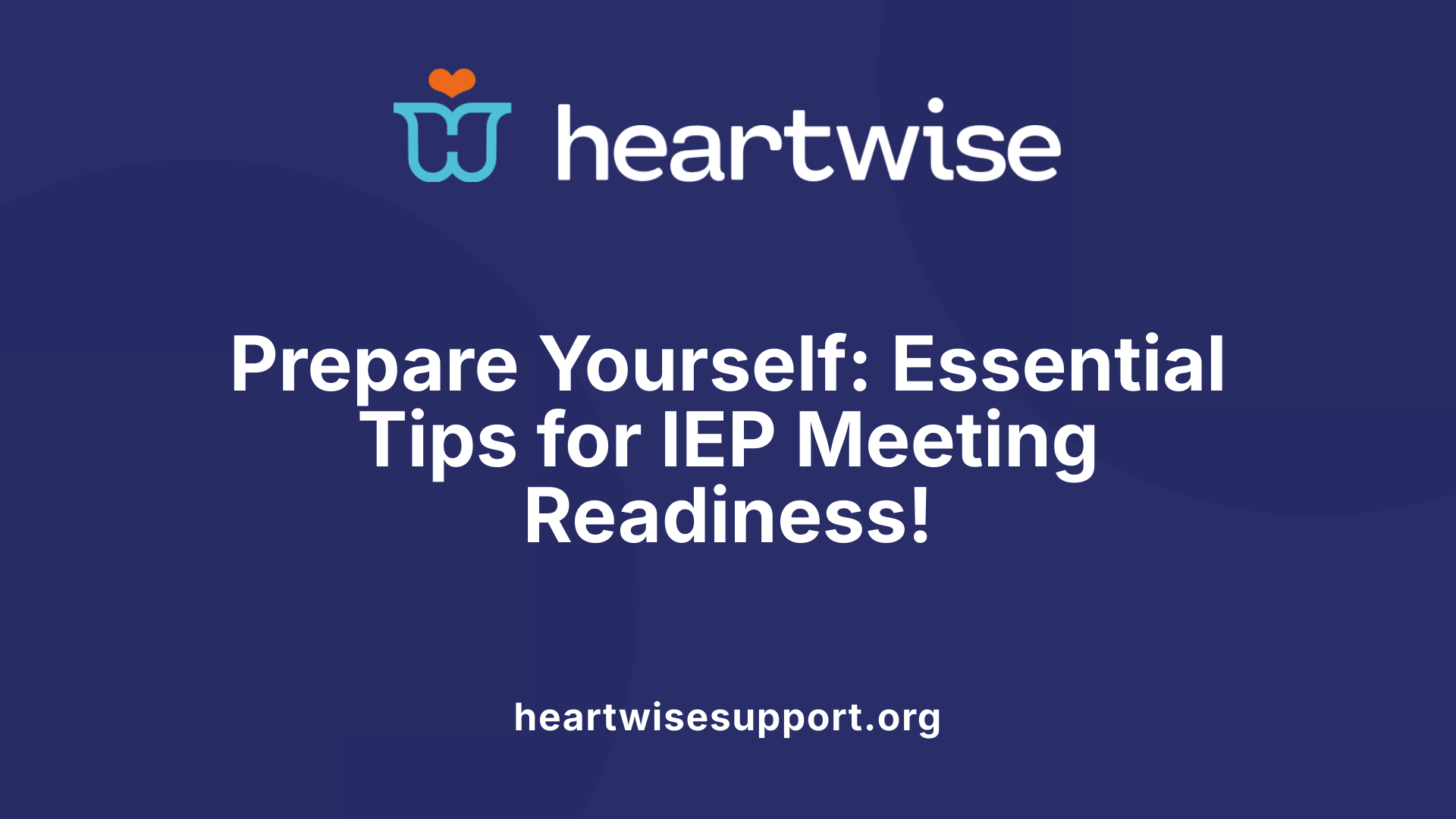Understanding IEP Meetings
Individualized Education Program (IEP) meetings are critical for shaping the educational path of students with special needs. These meetings, which involve educators, specialists, and often parents, are designed to draft educational plans tailored to the child’s unique requirements. Parents play an integral role in these discussions, and the presence of educational support advocates can be invaluable, helping parents navigate complex procedures, communicate effectively, and advocate for their child’s needs. This article explores how to navigate IEP meetings with the help of advocates, ensuring a collaborative and successful outcome.
Preparing for Successful IEP Meetings

How should one prepare for an IEP meeting?
Preparing for an IEP meeting is crucial for effectively advocating for your child. Start by reviewing your child's current IEP, assessments, and relevant homework. This will help you identify key issues and gather necessary documentation.
Create a list of specific questions and concerns you wish to discuss with the IEP team. This could include queries about your child's goals, necessary accommodations, and services that align with their needs. Drafting a parent vision statement can also be helpful, as it outlines your child's strengths and essential support required.
Connecting with other parents for insights can provide additional support and knowledge. It’s also a good idea to invite supportive guests to the meeting, such as advocates or attorneys. These individuals can help navigate the nuances of the IEP process and ensure your child’s needs are effectively communicated.
Be sure to inform the IEP team leader about any additional attendees and special arrangements in advance. Remember, you are not obligated to sign the IEP on the spot; take your time to review it further if necessary.
The Role and Benefits of Educational Support Advocates

What is the role of an advocate in an IEP meeting?
The role of an advocate in an IEP meeting is pivotal in supporting parents through the labyrinth of special education. Advocates help clarify a child’s educational needs and assist families in understanding the intricacies of the IEP process. They aid in interpreting evaluation results, ensuring parents grasp the implications these findings have for their child's learning environment.
Advocates are knowledgeable about educational laws and regulations, helping navigate the complexities of IEP meetings. They check documents for accuracy, advocate for necessary accommodations, and make certain that IEP goals are appropriately aligned with the child’s needs. By accompanying parents to meetings, advocates facilitate effective communication with school personnel, helping translate educational jargon into accessible language.
How does an advocate interpret educational data and law?
Educational advocates play a crucial role in interpreting evaluation data, guiding parents in setting meaningful, realistic goals within the IEP. Their understanding of both special education law and best practices ensures that parents are well-informed regarding their rights under the Individuals with Disabilities Education Act (IDEA).
By demystifying the legal jargon, advocates empower parents to make assertive and informed decisions regarding their child's education. This advocacy not only enhances the accountability of the schools but also ensures that children's rights to receive a Free Appropriate Public Education (FAPE) are upheld.
How do advocates facilitate communication?
Advocates significantly enhance communication during IEP meetings by acting as a bridge between families and educational professionals. They encourage parents to express their concerns while fostering a climate of collaboration and respect. Advocates are skilled in documenting discussions, ensuring that everything agreed upon is accurately reflected in the IEP, which serves as a legal contract between families and schools.
Moreover, the presence of an advocate can alleviate the emotional stress often associated with these meetings, allowing parents to focus on their child’s best interests. Overall, educational advocates contribute vital support, knowledge, and strategies, ensuring that every child receives the services they need to thrive academically.
Strategies for Positive Communication in IEP Meetings

What are effective communication strategies for IEP meetings?
Effective communication during IEP meetings is essential for fostering a collaborative environment that prioritizes a child's educational needs. Here are several strategies:
Active Listening: Paying attention to what is being said by all team members helps ensure everyone's concerns are acknowledged. Asking clarifying questions can deepen understanding, especially when complicated jargon is used.
Documentation: Keeping accurate notes of discussions and decisions made during the meeting is crucial. This creates a record of what was agreed upon and helps in maintaining accountability.
Prepare Thoroughly: Arriving well-prepared with relevant documents and a list of priority concerns focuses discussions on the child's needs. This preparation empowers parents to advocate for their child effectively.
Maintain Professionalism: Expressing gratitude towards the team can cultivate goodwill. A positive, respectful attitude can enhance relationships and facilitate smoother discussions.
Formal Communication: When significant changes or concerns arise, notifying the IEP team ahead of time can preempt misunderstandings and lead to more productive meetings.
Involve the Child: Encouraging the child to share their thoughts about their educational experience can provide invaluable insights that inform the IEP goals. Their involvement helps them feel empowered and valued.
Ongoing communication through regular meetings contributes to an adaptive IEP that evolves with the child’s changing needs, ensuring they receive the necessary support.
Collaborating Effectively to Meet Your Child's Educational Needs

How can parents ensure their child's educational needs are met through an IEP?
To effectively advocate for their child's educational needs through an IEP, parents should engage actively in the entire IEP process. This begins with participating in the development and review of the IEP. Parents bring invaluable insights about their child's strengths and challenges, which are critical for the IEP team, including educators and specialists, to create a personalized plan.
Creating a comprehensive IEP involves outlining specific, measurable goals along with the necessary services and accommodations tailored to meet each child’s needs. Once the IEP is established, regular monitoring of its implementation is crucial. Parents should assess their child's progress and remain alert to areas where goals may not be met, ensuring that they can address these issues in future meetings.
What steps can parents take if changes are necessary?
If parents feel their child’s needs are not being adequately addressed, they have the right to challenge decisions and request modifications to services. Understanding their rights under the Individuals with Disabilities Education Act (IDEA) empowers parents to advocate effectively for their child's inclusion and support within educational settings.
Here’s a summary table of key considerations:
| Key Considerations | Actions | Outcomes |
|---|---|---|
| Active Participation | Engage in IEP development | Personal insights included |
| Regular Monitoring | Assess and document progress | Identify areas needing adjustments |
| Advocate for Changes | Request modifications when needed | Tailored response to child's needs |
By fostering a collaborative approach with the IEP team, parents can significantly enhance their child's educational experience and outcomes.
Avoiding Common Pitfalls in IEP Meetings

What are common mistakes to avoid in IEP meetings, and how can they be addressed?
When it comes to IEP meetings, several common mistakes can undermine the process and affect the effectiveness of the plan. Failing to involve all relevant stakeholders is a major pitfall. Engaging all necessary participants, including parents, teachers, and specialists, ensures a comprehensive perspective on the child's needs. This involvement is not just beneficial but required under the Individuals with Disabilities Education Act (IDEA).
Another frequent error is predetermining placements or services before consultations with families, which excludes parents from meaningful participation. This procedural misstep can lead to frustration and a feeling of disempowerment. Furthermore, insufficient assembly of the IEP team can inadvertently violate IDEA specifications, creating gaps in the development of an effective program.
Lastly, substantive mistakes, like inadequate evaluation of a child's needs, can prevent a strong foundation for the IEP. Such oversights can violate a child's right to a Free Appropriate Public Education (FAPE).
To address these mistakes, schools should prioritize training for staff, establish clear communication channels, and hold regular team discussions to ensure adherence to both procedural and substantive requirements.
| Common Mistakes in IEP Meetings | Impact on IEP Quality | Possible Solutions |
|---|---|---|
| Failing to involve all stakeholders | Undermines decision-making | Engage all relevant parties |
| Predetermining services/placements | Excludes parent input | Consult families before decisions |
| Inadequate IEP team assembly | Violates IDEA requirements | Regularly review team composition |
| Insufficient evaluations | Hinders proper goal setting | Ensure comprehensive assessments |
By identifying and correcting these pitfalls, IEP meetings can become more effective collaborative efforts, leading to better outcomes for children.
Empowering Parents to Actively Participate in IEP Meetings
How can parents effectively participate in IEP meetings?
To effectively participate in IEP meetings, parents should prepare in advance. This includes gathering all relevant documentation, such as assessments, reports from therapists, and notes on their child's progress. A good understanding of their child's strengths and needs helps parents advocate effectively.
Familiarizing themselves with the IEP process and their rights under the Individuals with Disabilities Education Act (IDEA) is crucial. Parents should also be aware of who will be in attendance at the IEP meeting, including special and general education teachers, school psychologists, advocates, and anyone else who contributes to their child’s educational plan.
During the meeting, parents should actively listen and engage in discussions. Sharing concerns and asking questions enhances communication and ensures their viewpoints are acknowledged. They can bring advocates to help interpret jargon and facilitate discussion, which is especially valuable in emotionally charged situations.
Open communication is key. Parents can approach the meeting as hosts rather than guests, which fosters a collaborative environment. If needed, parents have the right to request additional meetings or adjustments to the IEP, ensuring ongoing support that caters to their child's evolving needs.
Using Resources and Support Systems Effectively
Seeking Help from Advocates and Coordinators
Engaging with advocates or educational coordinators can significantly enhance the IEP meeting experience for parents. These professionals are knowledgeable about special education laws and can help parents effectively communicate their child’s needs. Having someone present can also mitigate emotional stress during discussions, allowing parents to focus on their child's interests. Parents can bring advocates to meetings, tapping into their expertise to better navigate the complexities of the IEP process.
Utilizing IDEA Resources and Rights
Understanding the Individuals with Disabilities Education Act (IDEA) is crucial for parents engaged in IEP discussions. This law outlines the rights of children with disabilities and the responsibilities of educational institutions to provide a Free Appropriate Public Education (FAPE). Parents should familiarize themselves with relevant terms and documentation required for meetings. This knowledge can empower them to request specific accommodations and advocate firmly for their child’s educational needs.
Networking with Other Parents
Connecting with other parents of children with disabilities can be incredibly beneficial. Sharing experiences can provide insights into navigating IEP meetings, discussing successful strategies, and understanding schools' approaches to special education. Forming a supportive network fosters a sense of community, reduces feelings of isolation, and can enhance confidence when advocating for the rights and needs of their children.
Conclusion
Navigating IEP meetings effectively requires preparation, understanding, and advocacy. By leveraging the expertise of educational support advocates, parents can enhance their participation and collaborate more effectively with educators and specialists in crafting an IEP that addresses their child’s unique educational needs. Staying informed on individual rights, seeking support when necessary, and fostering positive communication with school staff are essential strategies to ensure that every child receives the education and support they deserve. Through active engagement and collaboration, parents can play a pivotal role in shaping a successful educational journey for their children with disabilities.
References
- IEP Meetings with Advocates and Attorneys – Tips for School ...
- 5 Tips for Communicating With Educational Advocates Before and ...
- Tips for Navigating IEPs - PALCO
- IEP Advocate – Essential Guide for Parents on Special Education ...
- Tips for Navigating an IEP Meeting: A Guide for Parents & Guardians
- 7 Ways an IEP Advocate Can Help You
- Navigating IEP meetings - Understood.org
- IEP Advocacy Moves for Parents – Part 1 - Mary Beth Gilliland

.png)









